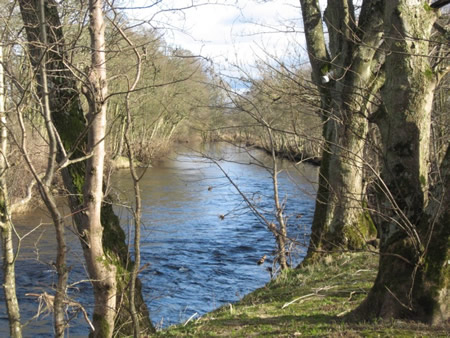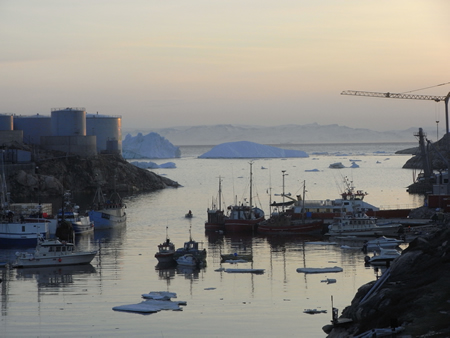These bulletin blogs represent news about Finavon and the South Esk, and my views as a riparian owner. They are not the views of any other organisation, nor are they designed to promote the interests of any individual or organisation other than Finavon Castle Water and factors affecting the fishery. Tony Andrews
There are many millions of tons of snow on the hills and in the corries. At some point most of this huge reservoir of water has to come down the river. In a few minutes from now I am going to fish a size 8 Willie Gunn with a cone head through Franks and Indies Pools on Indies Beat. I could say that I have a hunch, but I think that might be over-egging the situation. Put it like this: I fancy a wade down Indies and a cast or two into that wonnderful pool’s tail, as always, with a touch of optimism.
Tyndals pool in late winter sunshine in March 2013. This pool is a favourite resting place for spring salmon on their way up to the upper reaches of the South Esk, where they spend the summer months hunkered down in a deep holding pool.
The dogs took me for a walk early this morning down Milton Beat, and I have to say that Tyndals Pool was looking great. There must be a fish in the centre section of the pool, but the water is still very cold. The news from the Marine Scotland tagging is that at least two salmon have been trapped and tagged at Upper Kinnaird, and another one or two caught in the Usan nets. Catching spring salmon in fresh water well into the river makes a lot of sense after the 2012 experience of tagged fish travelling far and wide. That is not to suggest that salmon tagged, even as far up the river as Upper Kinnaird, won’t change their minds and go back to sea. Salmon are capricious animals, which is why we all love them!
This evening is just a lull between two cold snaps, or that is what the weather forecasters are telling us. The temperature this evening is about 7 C so maybe, just maybe, there is a fresh spring salmon in one of FCW’s pools. Next week will be colder. Time to go fishing….
This is where some of those fish I was trying to catch today come from. The photo is the town of Ilullissat 250 miles inside the arctic circle in Greenland, where genetic analysis of samples has shown some of our MSW salmon go to feed. (uncannily like a Claude Lorrain painting!)
Later: It was a lovely evening with the bright light of the sunset belying the chill of the water, which is very clear with a touch of snow melt. I never saw nor felt a fish but, as I mentioned earlier, it was just good to be there fishing down Indies with a fly that was clearly too small and probably wasn’t deep enough anyway. But the dogs enjoyed the outing with Tally Labrador joining me in midstream for a greeting before getting bored and getting back to what dogs do on riverbanks. The wild garlic is greening up the woods now and the snowdrops are definitely past their first flush of youth.
Roe deer are in the woods in good numbers too. Which reminds me, thinking of visiting mammals, that today I had a call from someone who works for the Courier newspaper asking me what my views are on beavers, because there are quite a number in the Dean Water, which is a short walk across the watershed from the Lemno Burn. I told him that I think of them as food. After all they are herbivors, and eat no end of good things in our countryside, which is a lot more than can be said for some of the processed offal we buy in the shops. I have in mind, when it is legal of course, a couple of spit-roasted beavers, well basted and with spuds baked in the fire embers with salad and lots of wine. I am sure that our syndicate members would enjoy a beaver party. Catch your beaver first.
But, to be serious for a moment, I am not in favour of introducing European beavers to the South Esk catchment because their well-built dams will obstruct upstream and downstream migrations of salmon and trout. That will inhibit regeneration of freshwater mussels because they depend on upstream migration of both species for the mussel larva (glochidia) to hitch a ride in their gills as the only way they can get upriver to regenerate their stock. A beaver dam would stop that happening, or at the very least restrict the range of the mollusc within the catchment. That would I imagine cause a flurry of confusion in SNH corridors as their employees try to decide whether freshwater mussels are more important than beavers. The argument – beavers versus mussels – will probably be resolved by external authority as Brussels might tell them which has priority, because it is conservation of the mussel (Margaritifera margaritifera) that gives the South Esk its SAC status. It’s a bit like the choice between buzzards and curlews or lapwings; someone in an office somewhere has to decide which species gets the thumbs down.
The other concern about beavers, which will tend to use the smaller, well forested, tributaries is that their dams inhibit downstream migrations of parr and pre smolts, making them vulnerable to predation when they collect in large numbers in the pool formed by the dam. One can imagine just about every riparian predator waiting for that concentration of fish to appear, courtesy of our Swedish beavers!
TA

